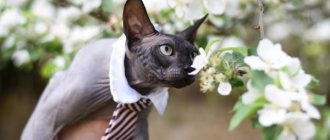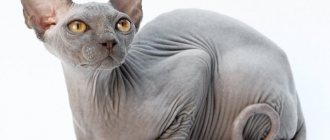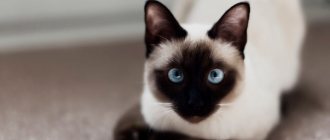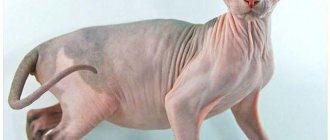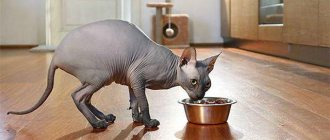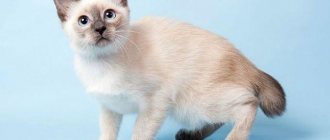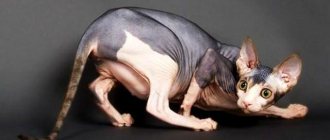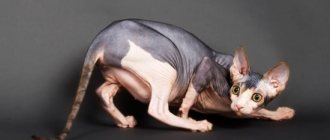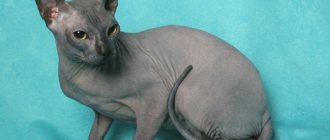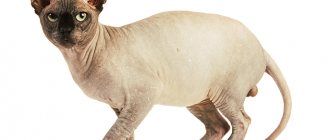Hairless cat breeds have won the love of many people, thanks to the magical attractiveness of their appearance, and due to their inherent good nature, loyalty and devotion. This breed is from the “for those who understand” series (see photo). It is unlikely that you will find in representatives of other breeds, besides this one, a special softness of outline, a special set of ears, or a specifically beautiful eye shape. The description of this breed of wonderful hairless cats with photographs and names offered for review will certainly increase the number of connoisseurs of these unusual representatives of the cat family.
Pink elf cat
The history of hairless cats
A brief historical and geographical information about the appearance of these “moon cats” (as they are often called) in the sublunary world is as follows. Mention of the hairless sphinx is found already in the first manuscripts - ancient Egyptian papyri. The first detailed description of a completely hairless cat breed dates back to 1903: in the work “The Book of the Cat” by Francis Simpson, we are talking about the appearance in Mexico of two hairless cats, brother and sister – Nellie and Dick. According to his story, hairless cats were originally “residents” of the Aztec tribes - the indigenous Mexican inhabitants, and were distinguished by their loyalty to their owners and intelligence. Due to their close relationship, they were not crossed by people, and the breed was temporarily “overwritten” by history.
After 35 years, R. Letard, a geneticist from France, receives two hairless kittens born in Paris into a “family” of Siamese cats. In 1950, also in France and also in a Siamese “family,” three hairless kittens were born, subsequently they were crossed with each other, and several more hairless babies were born. However, this scientific history did not receive further development.
In 1966, a hairless kitten was born in Canada. Subsequently, in order to restore the breed of hairless cats (Sphynx), it was decided to cross this already grown-up cat with his mother.
Pregnant Sphynx cat: soon there will be more “sphynxes” on Earth
Features of hairless cat breeds
What is the reason for the lack of hair in this breed of cats is still not completely clear; a stable scientific point of view on this matter has become a gene mutation that has become the rule. A characteristic feature of sphinxes, their prerogative, is the adoption of the “Dreamer” pose, especially pronounced among representatives of the hairless Cohona breed.
The Canadian Sphynx is a typical dreamer
A characteristic feature of the “moon cat” (this name reflects the version of its alien origin) is hairlessness, however, no one has yet succeeded in getting a hairless cat by simply shaving a “wool” cat.
Today, three subspecies of sphinxes are known: the Canadian sphinx, the Don sphinx and the St. Petersburg sphinx - Peterbald. For each subspecies, appropriate standards have been developed, and special organizations function to reproduce them (maintain their existence), the largest of which is the International Sphynx Fanciers and Breeders Association (ISBFA), located in the USA.
It is no coincidence that one of the varieties of hairless cats received the name elf: if in Scandinavian mythology they are friendly, magical people, then in the world of cats they are a kind cat, especially loving touches and hugs and therefore often following on the heels of the owner.
What is the name of this breed of hairless cats? I'm an elf. Isn't it clear?
Description and breed standards
The general hairless breed standard includes:
- unusually graceful body;
- developed muscles;
- very short/virtually absent hair;
- “velvet skin”;
- specifically located skin folds indicating that the animal belongs to a specific subspecies;
- long, coarse hairs (vibrissae) protruding above the surface of the skin/fur;
- membranes between fingers;
- skin's ability to tan;
- the habit of looking a person in the eye too persistently.
The shape of the head and body varies and depends on the subspecies of the hairless breed, which allows felinologists to differentiate them.
Almost “dog-like” devotion and temperament, which makes communication with them pleasant, are traits similar to all subspecies.
Each of the three currently known subspecies has specific features.
Thus, hairless cats of the Canadian Sphynx breed are different:
- wide, large ears, rounded at the ends;
- The common color among them is piebald, resulting from a combination of white in various combinations.
The Canadian Sphynx
of the Don Sphynx, a breed that originated in 1987 in Rostov-on-Don, can be distinguished by:
- very muscular body;
- wedge-shaped head;
- cheekbones and brow ridges that stand out strongly on the muzzle;
- flat forehead with pronounced vertical wrinkles;
- The color can be any, with the exception of chocolate and lilac.
Don skiff
The Petersburg Sphynx (Peterbald), bred in St. Petersburg in the early 2000s, not yet recognized by the international “cat” community, is distinguished by the fact that:
- its color can be absolutely anything;
- his eyes can only be blue or green.
I am Peterbald!
One of the youngest breeds of hairless cats - Bambino, which appeared as a result of crossing the Munchkin and the Sphinx, is distinguished by:
- wedge-shaped, rounded head with widely spaced almond-shaped eyes of blue, green, gray or topaz shade;
- elongated, strong body with a very strong back, athletic type;
- powerful, strong, very short legs;
- Any color except ticked (color with a pattern).
Sphinx Bambino
Minskin is a variety of Bambino, obtained in 1998 by crossing Munchkin and Sphinx with the “adding” of Devon Rex and Burmese, and is distinguished by the following typological features:
- strong resemblance to Bambino;
- short fur, slightly longer in the area of the paws, tail, ears and muzzle.
- completely bald, not half-bald belly;
- hair growing in islands on the naked body, like that of Siamese Points.
What kind of Bambino am I? I’m still quite a bambino-bambino….
Color options
Due to the lack of hair, the skin of these animals can acquire almost any color. The absence of hair also explains the fact that smoky individuals are not found among sphinxes. The patterns on their skin are very individual. Sunbathing by hairless cats can make their color much brighter and more saturated.
Solid colors of hairless cats can be: lilac, red, gray, black, pinkish, white, blue.
Pink and white sphinx. Remember: my name is Ukrainian Levkoy
Two-tone colors, as a rule: white-gray, gray-lilac, black-chocolate. There are also bicolor (white color combined with the main color), tabby color (pattern on the skin) and color point, reminiscent of the color of Siamese cats.
Gray-lilac Don sphinxes: yes, we are sphinxes!
Character and habits
Canadian Sphynx Dreamer
It is still unclear why hairless cats have such a pleasant disposition: did nature itself or are their traits determined by genetic programs for their breeding? Due to their friendly disposition, as well as their poor tolerance of separation from their owner, they are often compared to dogs.
Representatives of this breed are inquisitive (for this reason they are able to quickly move from place to place), sociable and intelligent, they are quite easy to train (if necessary). They have an excellent understanding of human speech, as well as a sensitive grasp of the owner’s tone; they are very sensitive. There is no need to doubt their ability to get along with children and other animals - they do it “on time”. There is also information about their special beneficial effect on the human psyche.
What you need to know if you decide to get a Sphynx
By nature, pets of this breed are inquisitive. This is inherent in their character, so it’s worth getting used to the unexpected. Little hairless kittens need an eye and an eye. The modest dimensions do not prevent the cubs from climbing onto tall pieces of furniture, but it is much more difficult for them to get down from there. With age, their curiosity does not disappear, but they become cautious and calm.
Those who are planning to get a Sphynx cat should take into account their characteristics. You need to read the reviews of people who have already acquired such a pet. In a large family, pets concentrate on one owner and become loyal only to him. They can choose as a patron both a person who shows maximum affection towards them, and an indifferent subject.
Beautiful, friendly, loyal, unlike the rest. These are all sphinxes. You should not get an unusual cat if you are not willing to spend time with him regularly. They do not tolerate indifference, need affection and generously reward it.
Rules of care and maintenance
The specificity of caring for hairless cats is mainly explained by their physiological characteristics: bare skin that requires delicate handling. For this reason, felinologists recommend that you wipe your pet daily with sanitary napkins. They need to be bathed twice a month, especially since they are very supportive of this: since they have sweat glands, their body can gradually become covered with a sebaceous film. You can use baby shampoo for bathing, taking into account that the Sphynx's temperature is slightly higher than that of representatives of other breeds, which means that the water for bathing them should be at least 38 degrees Celsius.
Due to their delicate coat, after bathing procedures it is under no circumstances recommended to use a hair dryer to dry these animals!
The ears and eyes of such cats, as well as the claws and paw pads, require daily hygiene, as a characteristic brown coating appears on them. Nails must be trimmed once a week to prevent the animal from getting injured from its long claws.
Prone to illness
The approach to keeping hairless cats should be based on common sense, which will ensure their healthy longevity. Common sense will minimize possible health problems for these pets, including:
- Getting burned, both from the sun and from radiators;
- Getting a cold easily in the cold;
- Respiratory diseases and pneumonia as a result of hypothermia;
- Tendency to dermatitis.
- Obesity, due to the incredible appetite that is characteristic of them.
Strict consideration by the owner of a hairless cat/cats of these specific circumstances will qualitatively prolong the life of the animal, whose average life is from 12 to 17 years, but there are often cases of their life up to 20 years.
Don Sphynx. Well, how can you not take care of something like that?
Characteristics of the Sphinx
| Attachment level | High |
| Friendliness | High |
| Suitable for children | Average |
| Loyalty to other pets | High |
| Exercise needs | Low |
| Playfulness | High |
| Energy level | High |
| Intelligence | High |
| Tendency to meow | High |
| Shedding intensity | Low |
Diet features
All representatives of hairless breeds have an excellent appetite caused by high energy metabolism. The daily amount of food they need is on average twice the amount needed by representatives of other breeds.
The owner needs to ensure that the pet’s diet is balanced:
Bald cats do not need a large amount of vitamins included in the diet of “wool” cats for growth and good condition of the coat; such vitamins can harm them;
The food should be saturated with fats - this is important for maintaining their usual body temperature.
The content of proteins and carbohydrates in purchased food for them corresponds to the normal level of their consumption by any cat.
The diet of hairless cats must include: dairy products, vegetables, liver, raw/cooked poultry or beef.
Adult cats and hairless cats must be protected from overeating!
Peterbald - St. Petersburg Sphynx: I prefer to remain as slender for a long time!
Physical activity and walks
Exactly the same as for people, i.e. Within reasonable limits, hairless cats need sunbathing. When exposed to the sun, their color becomes very beautiful, bright, and rich. However, like us, they can get burned. With the onset of warmer weather, the animal should be gradually accustomed to being in the air and the sun, while trying to avoid the midday heat. It is better for them to be in the shade. However, this does not mean that hairless cats need to be created in greenhouse conditions - they need and can be hardened. They just need physical activity and mobility in the fresh air.
Approximate winter wardrobe of a sphinx
Pros and cons of the Sphynx cat
pros
- The Sphynx is a loving, playful, loyal breed.
- Most Sphynx cats get along well with other cats and dogs.
- People who don't like cat hair or shedding cats will enjoy this breed.
Minuses
- Hairless, prone to sunburn and intolerant of cold.
- They are not hypoallergenic; dandruff and oil can cause allergies.
- This breed is prone to cardiomyopathy as well as skin and dental problems.
Is there an allergy to hairless cats?
The widespread belief that hairless cats are “allergy-free” has no scientific basis. Cat lovers who have allergic problems, as a rule, think about purchasing a hairless breed. However, these cats, like any other, can cause allergies. Scientists explain the occurrence of allergies from communication with cats by the presence in cats of almost all breeds of the Fel D1 protein, produced by the sebaceous glands of cats. This protein is found in cat urine, dead skin cells, and saliva, which means it gets onto the animal’s fur when it is washed.
There are no hypoallergenic hairless cats!
Ukrainian Levkoy: chic, but allergenic
Diseases of hairless cats
Diseases of hairless pussies primarily include acne. Most often it occurs in blue and red cats. If acne appears, it can be easily cured with the help of special medications.
Allergies are also common among bald people. Moreover, it can be for anything: detergents, flowers, fabrics. You can get rid of it only by eliminating the source.
During estrus, cats sometimes develop seasonal dermatitis. But, as a rule, it passes as quickly as it begins.
Unlike common and easily treatable diseases, hairless cats suffer from hereditary diseases that are almost impossible to cure: gum hyperplasia, carp bite, underdeveloped tail vertebrae, respiratory tract obstruction syndrome. There are also defects of the eyeball (the eye has to be removed) or entropion of the eyelids, which requires surgical intervention. In females, nipple hyperplasia and mammary gland diseases are sometimes observed.
Cats sometimes give birth to kittens that begin to “sleep” two weeks after birth. The babies practically fade away before our eyes and it is impossible to save them, and the reason lies in an abnormality of the thymus.
Despite this “bouquet”, with proper care, cats live on average 14-15 years, and can only suffer a mild cold in their entire life.
How to choose a kitten, cost
Hairless cats are a “scarce”, and therefore quite expensive, pleasure. The price for hairless kittens starts from 10 thousand and ends at 400 thousand rubles, it depends on the pedigree, class, color and age.
However, as a rule, breeders of hairless breeds have a waiting list of people willing to purchase them, so you need to worry about purchasing them in advance. It is best to do this in nurseries, where they are able to preserve the hairless gene in animals.
On the market for hairless kittens, Cohon is of particular value due to its rarity; for this reason, its value is individual.
A new “Kokhonyonok” was born
Hairless cats are not among those pets that are usually bred en masse at home.
But the little boy has already grown up
Description of the Sphynx breed
Sphynxes, a member of the cat family, were named after the legendary Egyptian sphinx for their sophisticated appearance and graceful nature.
Despite their regal appearance, they are playful companions, sometimes more like dogs than cats. They may look like they were pets of the pharaohs, but they are actually native to Canada.
Sphynxes stand out among other domestic animals due to their lack of hair, a rarity among most mammals.
These non-furry felines love to stretch out in the sun whenever possible to warm up. They are great cuddle dogs and prefer to snuggle under the covers with their owners at night.
Hairless cats: TOP 10 breeds
The most common varieties of hairless cats include:
- Elf
- Don skiff
- Bambino
- Minskin - a variety of Bambino
- Canadian Sphynx
- Varieties of skiff: Brush, Brush-point, Flock
- Sphinx of Kohona
Sphinx of Kohona
- Peterbald
The Peterbalds
- Ukrainian Levkoy
Let's get acquainted: we are Ukrainian Levkos!
